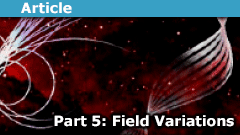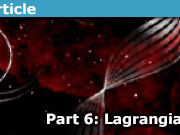Learn Field Variations in Mathematical Quantum Field Theory
This is chapter 4 of a series on Mathematical Quantum Field Theory.
The previous chapter is 3. Fields.
The next chapter is 5. Lagrangians.
4. Field variations
Given a field bundle as in def. 3.1 above, then we know what type of quantities the corresponding field histories assign to a given spacetime point (a given event). Among all consistent such field histories, some are to qualify as those that “may occur in reality” if we think of the field theory as a means to describe parts of the observable universe. Moreover, if the reality to be described does not exhibit “action at a distance” then admissibility of its field histories should be determined over arbitrary small spacetime regions, in fact over the infinitesimal neighbourhood of any spacetime point (remark 4.3 below). This means equivalently that the realized field histories should be those that satisfy a given differential equation, namely an equation between the partial derivatives of the field history at any spacetime point. This is called the equation of motion of the field theory (def. 5.17 below).
In order to formalize this, it is useful to first collect all the possible partial derivatives that a field history may have at any given point into one big space of “field derivatives at spacetime points”. This collection is called the jet bundle of the field bundle, given as def. 4.1 below.
Moving around in this space means to change the possible value of fields and their derivatives, hence to vary the fields. Accordingly variational calculus of fields is just differential calculus on the jet bundle of the field bundle, this we consider in def. 4.10 below.
Definition 4.1. (jet bundle of a trivial vector bundle over Minkowski spacetime)
Given a field fiber super vector space ##F = \mathbb{R}^{b\vert s}## with linear basis ##(\phi^a)##, then for ##k \in \mathbb{N}## a natural number, the order-##k## jet bundle
$$
\array{
J^k_{\Sigma}( E )
\\
\downarrow^{\rlap{jb_k}}
\\
\Sigma
}
$$
over Minkowski spacetime ##\Sigma## of the trivial vector bundle
$$
E := \Sigma \times F
$$
is the super Cartesian space (def. 3.36) which is spanned by coordinate functions to be denoted as follows:
$$
\left(
(x^\mu)
\,,\,
(\phi^a )
\,,\,
( \phi^a_{,\mu} )
\,,\,
( \phi^a_{,\mu_1\mu_2} )
\,,\,
\cdots
\,,\,
( \phi^a_{,\mu_1 \cdots \mu_k} )
\,,\,
\cdots
\right)
$$
where the indices ##\mu, \mu_1, \mu_2, \cdots## range from 0 to ##p##, while the index ##a## ranges from ##1## to ##b## for the even field coordinates, and them from ##b+1## to ##b+s## for the odd-graded field coordinates. In terms of these coordinates the bundle projection map ##jb_k## is just the one that remembers the spacetime coordinates ##x^\mu## and forgets the values of the field ##\phi^a## and its derivatives ##\phi_{\mu}##. Similarly there are intermediate projection maps
$$
\array{
\cdots
&\overset{jb_{3,2}}{\longrightarrow}&
J^{2}_\Sigma(E)
&\overset{jb_{2,1}}{\longrightarrow}&
J^1_\Sigma(E)
&\overset{jb_{1,0}}{\longrightarrow}&
E
\\
&& &{}_{\llap{jb_2}}\searrow& {}^{\llap{jb_1}}\downarrow &\swarrow_{\rlap{fb}}&
\\
&& && \Sigma &&
}
$$
given by forgetting coordinates with more indices.
The infinite-order jet bundle
$$
J^\infty_\Sigma(E) \in SuperSmoothSet
$$
is the direct limit of super smooth sets (def. 3.39) over these finite order jet bundles. Explicitly this means that it is the smooth set which is defined by the fact that a smooth function (a plot, by prop. 3.41)
$$
U \overset{f}{\longrightarrow} J^\infty_\Sigma(E)
$$
from some super Cartesian space ##U## is equivalently a system of ordinary smooth functions into all the finite-order jet spaces
$$
\left(
U \overset{f_k}{\longrightarrow} J^k_\Sigma(E)
\right)_{k \in \mathbb{N}}
\,,
$$
such that this system is compatible with the above projection maps, i.e. such that
$$
\underset{k \in \mathbb{N}}{\forall} \left(
jb_{k+1,k} \circ f_{k+1} = f_k
\right)
\phantom{AAAAAAA}
\array{
&& && U &&
\\
&& & {}^{\llap{f_2}}\swarrow& {}_{\llap{f_1}}\downarrow &\searrow^{f_0}&
\\
\cdots
&\overset{jb_{3,2}}{\longrightarrow}&
J^{2}_\Sigma(E)
&\overset{jb_{2,1}}{\longrightarrow}&
J^1_\Sigma(E)
&\overset{jb_1}{\longrightarrow}&
E
\\
&& &{}_{\llap{jb_2}}\searrow& {}^{\llap{jb_1}}\downarrow &\swarrow_{\rlap{fb}}&
\\
&& && \Sigma &&
}
$$
The coordinate functions ##\phi^a_{\mu_1 \cdots \mu_k}## on a jet bundle (def. 4.1) are to be thought of as partial derivatives ##\frac{\partial}{\partial x^{\mu_1}} \cdots \frac{\partial}{\partial x^{\mu_k}} \Phi^a## of components ##\Phi^a## of would-be field histories ##\Phi##. The power of the jet bundle is that it allows to disentangle relations between would-be partial derivatives of field history components in themselves from consideration of actual field histories. In traditional physics texts this is often done implicitly. We may make it fully explit by the operation of jet prolongation which reads in a field history and records all its partial derivatives in the form of a section of the jet bundle:
Definition 4.2. (jet prolongation)
Let ##E \overset{fb}{\to} \Sigma## be a field bundle (def. 3.1) which happens to be a trivial vector bundle over Minkowski spacetime as in example 3.4.
There is a smooth function from the space of sections of ##E##, the space of field histories (example 3.44) to the space of sections of the jet bundle ##J^\infty_\Sigma(E) \overset{jb^\infty}{\to} \Sigma## (def. 4.1) which records the field ##\Phi## and all its spacetimes derivatives:
$$
\array{
\Gamma_\Sigma(E)
&\overset{j^\infty_\Sigma}{\longrightarrow}&
\Gamma_\Sigma(J^\infty_\Sigma(E))
\\
(\Phi^a)
&\mapsto&
\left(
\left( \Phi^a \right)
\,,\,
\left( \frac{\partial \Phi^a}{\partial x^\mu} \right)
\,,\,
\left( \frac{\partial^2 \Phi^a}{\partial x^{\mu_1} \partial x^{\mu_2}} \right)
\,,\,
\cdots
\right)
}
\,.
$$
This is called the operation of jet prolongation: ##j^\infty_\Sigma(\Phi)## is the jet prolongation of ##\Phi##.
Remark 4.3. (jet bundle in terms of synthetic differential geometry)
In terms of the infinitesimal geometry of formal smooth sets (def. 3.23) the jet bundle ##J^\infty_\Sigma(E) \overset{jb_\infty}{\to} \Sigma## (def. 4.1) of a field bundle ##E \overset{fb}{\to}\Sigma## has the following incarnation:
A section of the jet bundle over a point ##x \in \Sigma## of spacetime (an event), is equivalently a section of the original field bundle over the infinitesimal neighbourhood ##\mathbb{D}_x## of that point (example 3.29):
$$
\left\{
\array{
&& J^\infty_\Sigma(E)
\\
& \nearrow & \downarrow^{\rlap{jb_\infty}}
\\
\{x\}
&\hookrightarrow&
\Sigma
}
\phantom{AA}
\right\}
\phantom{AA}
\simeq
\phantom{AA}
\left\{
\array{
&& E
\\
& {}^{\llap{}}\nearrow & \downarrow^{\rlap{fb}}
\\
\mathbb{D}_x &\hookrightarrow& \Sigma
}
\phantom{AA}
\right\}
\,.
$$
Moreover, given a field history ##\Phi##, hence a section of the field bundle, then its jet prolongation ##j^\infty(\Phi)## (def. 4.2) is that section of the jet bundle which under the above identification is simply the restriction of ##\Phi## to the infinitesimal neighbourhood of ##x##:
$$
\array{
&& E
\\
& {}^{\llap{\Phi}}\nearrow & \downarrow^{\rlap{fb}}
\\
\Sigma & = & \Sigma
}
\phantom{AAAA}\overset{j^\infty_\Sigma}{\mapsto} \phantom{AAAA}
\array{
&& J^\infty_\Sigma(E)
\\
& {}^{\llap{j^\infty_\Sigma(\Phi)}}\nearrow & \downarrow^{\rlap{jb_\infty}}
\\
\Sigma &=& \Sigma
}
\phantom{AAAA}
\overset{(-)\vert_{\{x\}} }{\mapsto}
\phantom{AAAA}
\array{
&& E
\\
& {}^{\llap{\Phi\vert_{\mathbb{D}_x}}}\nearrow & \downarrow^{\rlap{fb}}
\\
\mathbb{D}_x &\hookrightarrow& \Sigma
}
\,.
$$
This follows with an argument as in example 3.20.
Hence in synthetic differential geometry we have:
The jet of a section ##\Phi## at ##x## is simply the restriction of that section to the infinitesimal neighbourhood of ##x##.
(Khavkine-Schreiber 17, section 3.3)
So the canonical coordinates on the jet bundle are the spacetime-point-wise possible values of fields and field derivates, while the jet prolongation picks the actual collections of field derivatives that may occur for an actual field history.
Example 4.4. (universal Faraday tensor/field strength on jet bundle)
Consider the field bundle (def. 3.1) of the electromagnetic field (example 3.6) over Minkowski spacetime ##\Sigma## (def. 2.17), i.e. the cotangent bundle ##E = T^\ast \Sigma## (def. 1.15) with jet coordinates ##((x^\mu), (a_\mu), (a_{\mu,\nu}), \cdots )## (def. 4.1). Consider the functions on the jet bundle given by the linear combinations
| $$ \label{FaradayTensorJet} f_{\mu \nu} \;:=\; \tfrac{1}{2}\left( a_{\mu,\nu} – a_{\nu,\mu} \right) $$ | (25) |
of the first order jets.
Then for an electromagnetic field history (“vector potential”), hence a section
$$
A \in \Gamma_\Sigma(T^\ast \Sigma) = \Omega^1(\Sigma)
$$
with components ##A^\ast (a_\mu) = A_\mu##, its jet prolongation (def. 4.2)
$$
j^\infty_\Sigma(A) \in \Gamma_\Sigma(J^\infty_\Sigma(T^\ast \Sigma))
$$
has components
$$
\left(
(A_\mu),
\left(
\frac{d A_\mu}{d x^\nu}
\right)
,
\cdots
\right)
\,.
$$
The pullback of the functions ##f_{\mu \nu}## (25) along this jet prolongation are the components of the Faraday tensor of the field (17):
$$
\begin{aligned}
\left(j^\infty_\Sigma(A)\right)^\ast(f_{\mu \nu})
& =
F_{\mu \nu}
\\
& =
(d A)_{\mu \nu}
\,.
\end{aligned}
$$
More generally, for ##\mathfrak{g}## a Lie algebra and
$$
E := T^\ast \Sigma \otimes \mathfrak{g}
$$
the field bundle for Yang-Mills theory from example 3.7, consider the functions on the jet bundle given by
$$
D_\mu a_\nu^\alpha
\;:=\;
a^\alpha_{[\nu,\mu]}
+
\tfrac{1}{2}
\gamma^{\alpha}{}_{\beta \gamma}
a^\beta_{[\mu} a^\gamma_{\nu]}
$$
where ##(\gamma^\alpha{}_{\beta \gamma})## are the structure constants of the Lie algebra as in (18), and where the square brackets around the indices denote anti-symmetrization. For ##\mathfrak{g} = \mathbb{R}## the line Lie algebra this reduces to the universal Faraday tensor (25) for the electromagnetic field (example 4.4).
For ##A \in \Gamma_\Sigma(T^\ast \Sigma \otimes \mathfrak{g}) = \Omega^1(\Sigma,\mathfrak{g})## a field history of Yang-Mills theory, hence a Lie algebra-valued differential 1-form, then the value of this function on that field are called the components of the covariant exterior derivative or field strength
$$
\begin{aligned}
F_{\mu \nu}
& :=
A^\ast(D_\mu a_n)
\\
& =
(d_A A)_{\mu \nu}
\end{aligned}
$$
While the jet bundle is not finite dimensional, reflecting the fact that there are arbitrarily high orders of spacetime derivatives of a field histories, it turns out that it is only very “mildly infinite dimensional” in that smooth functions on jet bundles turn out to locally depend on only finitely many of the jet coordinates (i.e. only on a finite order of spacetime derivatives). This is the content of the following prop. 4.5.
This reflects the locality of Lagrangian field theory defined over jet bundles: If functions on the jet bundle could depend on infinitely many jet coordinates, then by Taylor series expansion of fields the function at one point over spacetime could in fact depend on field history values at a different point of spacetime. Such non-local dependence is ruled out by prop. 4.5 below.
In practice this means that the situation is very convenient:
- Any given local Lagrangian density (which will define a field theory, we come to this in def. 5.1 below) will locally depend on some finite number ##k## of derivatives and may hence locally be treated as living on the ordinary manifold ##J^k_\Sigma(E)##.
- while at the same time all formulas (such as for the Euler-Lagrange equations, def. 5.17) work uniformly without worries about fixing a maximal order of derivatives.
Proposition 4.5. (jet bundle is a locally pro-manifold)
Given a jet bundle ##J^\infty_\Sigma(E)## as in def. 4.1, then a smooth function out of it
$$
J^\infty_\Sigma(E) \longrightarrow X
$$
is such that around each point of ##J^\infty_\Sigma(E)## there is a neighbourhood ##U \subset J^\infty_\Sigma(E)## on which it is given by a function on a smooth function on ##J^k_\Sigma(E)## for some finite ##k##.
(see Khavkine-Schreiber 17, section 2.2 and 3.3)
Example 4.4 shows that the de Rham differential (def. 1.18) may be encoded in terms of composing jet prolongation with a suitable function on the jet bundle. More generally, jet prolongation neatly encodes (possibly non-linear) differential operators:
Definition 4.6. (differential operator)
Let ##E_1 \overset{fb_1}{\to} \Sigma## and ##E_2 \overset{fb_2}{\to} \Sigma## be two smooth fiber bundles over a common base space ##\Sigma##. Then a (possibly non-linear) differential operator from sections of ##E_1## to sections of ##E_2## is a bundle morphism from the jet bundle of ##E_1## (def. 4.1) to ##E_2##:
$$
\array{
J^\infty_\Sigma(E_1)
&& \overset{\tilde D}{\longrightarrow} &&
E_2
\\
& \searrow && \swarrow
\\
&& \Sigma
}
$$
or rather the function ##D## between the spaces of sections of these bundles which this induces after composition with jet prolongation (def. 4.2):
$$
D
\;\colon\;
\Gamma_\Sigma(E_1)
\overset{j^\infty_\Sigma}{\longrightarrow}
\Gamma_\Sigma(J^\infty_\Sigma(E_1))
\overset{\tilde D \circ (-)}{\longrightarrow}
\Gamma_\Sigma(E_2)
\,.
$$
If both ##E_1## and ##E_2## are vector bundles (def. 1.10) so that their spaces of sections canonically are vector spaces, then ##D## is called a linear differential operator if it is a linear function between these vector spaces. This means equivalently that ##\tilde D## is a linear function in jet coordinates.
Definition 4.7. (normally hyperbolic differential operator on Minkowski spacetime)
Let ##E \overset{fb}{\to} \Sigma## be a field bundle (def. 3.1) which is a vector bundle (def. 1.10) over Minkowski spacetime (def. 2.17). Write ##E^\ast \overset{}{\to} \Sigma## for its dual vector bundle (def. 1.13)
A linear differential operator (def. 4.6)
$$
P
\;\colon\;
\Gamma_\Sigma(E)
\longrightarrow
\Gamma_{\Sigma}(E^\ast)
$$
is of second order if it has a coordinate expansion of the form
$$
(P \Phi)_a
\;=\;
P^{\mu \nu}_{a b} \frac{\partial^2 \Phi^b}{\partial x^\mu \partial x^\nu}
+
P^\mu_{a b} \frac{\partial \Phi^b}{\partial x^\mu}
+
P_{a b} \Phi^b
$$
for ##\{(P^{\mu \nu}_{a b}), (P^\mu_{a b}), P_{a b}\}## smooth functions on ##\Sigma##.
This is called a normally hyperbolic differential operator if its principal symbol ##(P^{\mu \nu}_{a b})## is proportional to the inverse Minkowski metric (prop./def. 2.15) ##(\eta^{\mu \nu})##, i.e.
$$
P^{\mu \nu}_{a b} = \eta^{\mu \nu} Q_{a b}
\,.
$$
Definition 4.8. (formally adjoint differential operators)
Let ##E \overset{fb}{\to} \Sigma## be a smooth vector bundle (def. 1.10) over Minkowski spacetime ##\Sigma = \mathbb{R}^{p,1}## (def. 2.17) and write ##E^\ast \to \Sigma## for the dual vector bundle (def. 1.13).
Then a pair of linear differential operators (def. 4.6) of the form
$$
P, P^\ast
\;\colon\;
\Gamma_\Sigma(E_1)
\longrightarrow
\Gamma_\Sigma(E^\ast)
$$
are called formally adjoint differential operators via a bilinear differential operator
| $$ \label{FormallyAdjointDifferentialOperatorWitness} K \;\colon\; \Gamma_\Sigma(E) \otimes \Gamma_\Sigma(E) \longrightarrow \Gamma_\Sigma(\wedge^{p} T^\ast \Sigma) $$ | (26) |
with values in differential p-forms (def. 1.17) such that for all sections ##\Phi_1, \Phi_2 \in \Gamma_\Sigma(E)## we have
$$
\left(
P(\Phi_1) \cdot \Phi_2
–
\Phi_1 \cdot P^\ast(\Phi_2)
\right) dvol_\Sigma
\;=\;
d K(\Phi_1, \Phi_2)
\,,
$$
where ##dvol_\Sigma## is the volume form on Minkowski spacetime (8) and where ##d## denoted the de Rham differential (def. 1.18).
(Khavkine 14, def. 2.4)
Remark 4.9. (variational calculus — replacing plain bundle morphisms by differential operators)
Various concepts in variational calculus, especially the concept of evolutionary vector fields (def. 6.2 below) and gauge parameterized implicit infinitesimal gauge symmetries (def. 10.5 below) follow from concepts in plain differential geometry by systematically replacing plain bundle morphisms by bundle morphisms out of the jet bundle, hence by differential operators ##\tilde D## as in def. 4.6.
Definition 4.10. (variational derivative and total spacetime derivative — the variational bicomplex)
On the jet bundle ##J^\infty_\Sigma(E)## of a trivial super vector space-vector bundle over Minkowski spacetime as in def. 4.1 we may consider its de Rham complex of super differential forms (def. 3.38); we write its de Rham differential (def. 1.18) in boldface:
$$
d \;\colon\; \Omega^\bullet(J^\infty_\Sigma(E)) \longrightarrow \Omega^{\bullet+1}(J^\infty_\Sigma(E))
\,.
$$
Since the jet bundle unifies spacetime with field values, we want to decompose this differential into a contribution coming from forming the total derivatives of fields along spacetime (“horizontal derivatives”), and actual variation of fields at a fixed spacetime point (“vertical derivatives”):
The total spacetime derivative or horizontal derivative on ##J^\infty_\Sigma(E)## is the map on differential forms on the jet bundle of the form
$$
d
\;\colon\;
\Omega^\bullet( J^\infty_\Sigma(E) )
\longrightarrow
\Omega^{\bullet+1}( J^\infty_\Sigma(E) )
$$
which on functions ##f \colon J^\infty_\Sigma(E) \to \mathbb{R}## (i.e. on 0-forms) is defined by
| $$ \label{SpacetimeTotalDerivativeOnSmoothFunctions} \begin{aligned} d f & := \frac{d f}{d x^\mu} \mathbf{d} x^\mu \\ & := \left( \frac{\partial f}{\partial x^\mu} + \frac{\partial f}{\partial \phi^a} \phi^a_{,\mu} + \frac{ \partial f }{ \partial \phi^a_{,\nu}} \phi^a_{,\nu \mu } + \cdots \right) \mathbf{d} x^\mu \end{aligned} $$ | (27) |
and extended to all forms by the graded Leibniz rule, hence as a nilpotent derivation of degree +1.
The variational derivative or vertical derivative
| $$ \label{VariationalDerivative} \delta \;\colon\; \Omega^\bullet( J^\infty_\Sigma(E) ) \longrightarrow \Omega^{\bullet+1}( J^\infty_\Sigma(E) ) $$ | (28) |
is what remains of the full de Rham differential when the total spacetime derivative (horizontal derivative) is subtracted:
| $$ \label{VerticalDerivative} \delta := \mathbf{d} – d \,. $$ | (29) |
We may then extend the horizontal derivative from functions on the jet bundle to all differential forms on the jet bundle by declaring that
$$
d \circ \mathbf{d} \;:=\; – \mathbf{d} \circ d
$$
which by (29) is equivalent to
| $$ \label{HorizontalAndVerticalDerivativeAnticommute} d \circ \;\delta\; = – \delta \circ d \,. $$ | (30) |
For example
$$
\begin{aligned}
d \delta \phi
& =
– \delta d \phi
\\
& =
– \delta \left( \phi_{,\mu} d x^\mu \right)
\\
& = – \delta \phi_{,\mu} \wedge d x^\mu
\,.
\end{aligned}
$$
This defines a bigrading on the de Rham complex of ##J^\infty_\Sigma(E)##, into horizontal degree ##r## and vertical degree ##s##
$$
\Omega^\bullet\left( J^\infty_\Sigma(E) \right)
\;:=\;
\underset{r,s}{\oplus} \Omega^{r,s}(E)
$$
such that the horizontal and vertical derivative increase horizontal or vertical degree, respectively:
| $$ \label{VariationalBicomplexDiagram} \array{ C^\infty(J^\infty_\Sigma(E)) = & \Omega^{0,0}(E) &\overset{d}{\longrightarrow}& \Omega^{1,0}_\Sigma(E) &\overset{d}{\longrightarrow}& \Omega^{2,0}_\Sigma(E) &\overset{d}{\longrightarrow}& \cdots &\overset{d}{\longrightarrow}& \Omega^{p+1,0}_\Sigma(E) \\ & \downarrow^{\rlap{\delta}} && \downarrow^{\rlap{\delta}} && \downarrow^{\rlap{\delta}} && \cdots && \downarrow^{\rlap{\delta}} \\ & \Omega^{0,1}_\Sigma(E) &\overset{d}{\longrightarrow}& \Omega^{1,1}_\Sigma(E) &\overset{d}{\longrightarrow}& \Omega^{2,1}_\Sigma(E) &\overset{d}{\longrightarrow}& \cdots &\overset{d}{\longrightarrow}& \Omega^{p+1,1}_\Sigma(E) \\ & \downarrow^{\rlap{\delta}} && \downarrow^{\rlap{\delta}} && \downarrow^{\rlap{\delta}} && \cdots && \downarrow^{\rlap{\delta}} \\ & \Omega^{0,2}(E) &\overset{d}{\longrightarrow}& \Omega^{1,2}(E) &\overset{d}{\longrightarrow}& \Omega^{2,2}(E) &\overset{d}{\longrightarrow}& \cdots &\overset{d}{\longrightarrow}& \Omega^{p+1,2}_\Sigma(E) \\ & \downarrow^{\rlap{\delta}} && \downarrow^{\rlap{\delta}} && \downarrow^{\rlap{\delta}} && \cdots && \downarrow^{\rlap{\delta}} \\ & \vdots && \vdots && \vdots } \,. $$ | (31) |
This is called the variational bicomplex.
Accordingly we will refer to the differential forms on the jet bundle often as variational differential forms.
derivatives on jet bundle
| def. | symbols | name in physics | name in mathematics |
| def. 3.38 | ##\; \mathbf{d}## | de Rham differential | de Rham differential |
| 4.10 | ##\; d := d x^\mu \frac{d}{d x^\mu}## | total spacetime derivative | horizontal derivative |
| 4.10 | ## \; \frac{d}{d x^\mu} := \frac{\partial}{\partial x^\mu} + \phi^a_{,\mu} \frac{\partial}{\partial \phi^a} + \cdots ## | total spacetime derivative along ##\partial_\mu## | horizontal derivative along ##\partial_\mu## |
| 4.10 | ##\; \delta := \mathbf{d} – d## | variational derivative | vertical derivative |
| 5.8 | ##\; \delta_{EL} \mathbf{L} := \mathbf{d}\mathbf{L} + d \Theta_{BFV}## | Euler-Lagrange variation | Euler-Lagrange operator |
| 7.30 | ##\; s_{BV}## | BV-differential | Koszul differential |
| 10.15 | ##\; s_{BRST} ## | BRST differential | Chevalley-Eilenberg differential |
| 11.11 | ##\; s ## | BV-BRST differential | Chevalley-Eilenberg-Koszul-Tate differential |
| 11.16 | ##\; s – d ## | local BV-BRST differential |
Example 4.11. (basic facts about variational calculus)
Given the jet bundle of a field bundle as in def. 4.1, then in its variational bicomplex (def. 4.10) we have the following:
- The spacetime total derivative (horizontal derivative) of a spacetime coordinate function ##x^\mu## coincides with its ordinary de Rham differential$$
\begin{aligned}
d x^\mu
& =
\frac{\partial x^\mu}{ \partial x^\nu} \mathbf{d}x^\nu
\\
& = \mathbf{d} x^\mu
\end{aligned}
$$which hence is a horizontal 1-form$$
\mathbf{d}x^\mu \;\in\; \Omega^{1,0}_\Sigma(E)
\,.
$$ - Therefore the variational derivative (vertical derivative) of a spacetime coordinate function vanishes:$$
\delta x^\mu = 0
\,,
$$reflective the fact that ##x^\mu## is not a field coordinate that could be varied. - In particular the given volume form on ##\Sigma## gives a horizontal ##p+1##-form on the jet bundle, which has the same coordinate expression (and which we denote by the same symbol)$$
dvol_\Sigma = d x^0 \wedge d x^1 \wedge \cdots \wedge d x^p
\;\in\;
\Omega^{p+1,0}
\,.
$$ - Generally any horizontal ##k##-form is of the form$$
f_{\mu_1 \cdots \mu_k} d x^{\mu_1} \wedge \cdots \wedge d x^{\mu_k}
\;\in\;
\Omega^{k,0}_{\Sigma}(E)
$$for$$
f_{\mu_1 \cdots \mu_k} = f_{\mu_1 \cdots \mu_k}\left((x^\mu), (\phi^a), (\phi^a_{,\mu}), \cdots\right)
\in C^\infty(J^\infty_\Sigma(E))
$$any smooth function of the spacetime coordinates and the field coordinates (locally depending only on a finite order of these, by prop. 4.5). - In particular every horizontal ##(p+1)##-form ##\mathbf{L} \in \Omega^{p+1,0}(E)## is proportional to the above volume form$$
\mathbf{L} = L \, dvol_\Sigma
$$for ##L = L((x^\mu), (\phi^a), (\phi^a_{,\mu}), \cdots)## some smooth function that may depend on all the spacetime and field coordinates. - The spacetimes total derivatives /horizontal derivatives) of the variational derivative (vertical derivative) ##\delta \phi## of a field variable is the differential 2-form of horizontal degree 1 and vertical degree 1 given by$$
\begin{aligned}
d (\delta \phi^a)
& =
–
\delta (d \phi_a)
\\
& =
– (\delta \phi^a_{,\mu}) \wedge \mathbf{d} x^\mu
\end{aligned}
\,.
$$In words this says that “the spacetime derivative of the variation of the field is the variation of its spacetime derivative”.
The following are less trivial properties of variational differential forms:
Proposition 4.12. (pullback along jet prolongation compatible with total spacetime derivatives)
Let ##E \overset{fb}{\to} \Sigma## be a field bundle over a spacetime ##\Sigma## (def. 3.1), with induced jet bundle ##J^\infty_\Sigma(E)## (def. 4.1).
Then for ##\Phi \in \Gamma_\Sigma(E)## any field history, the pullback of differential forms (def. 1.20)
$$
j^\infty_\Sigma(\Phi)^\ast
\;\colon\;
\Omega^\bullet(J^\infty_\Sigma(E))
\longrightarrow
\Omega^\bullet(\Sigma)
$$
along the jet prolongation of ##\Phi## (def. 4.2)
- intertwines the de Rham differential on spacetime (def. 1.15) with the total spacetime derivative (horizontal derivative) on the jet bundle (def. 4.10):$$
d \circ j^\infty_\Sigma(\Phi)^\ast
\;=\;
j^\infty_\Sigma(\Phi)^\ast \circ d
\,.
$$ - annihilates all vertical differential forms (def. 4.10):$$
j^\infty_\Sigma(\Phi)^\ast\vert_{\Omega^{r, \geq 1}_\Sigma(E)} = 0
\,.
$$
Proof. The operation of pullback of differential forms along any smooth function intertwines the full de Rham differentials (prop. 1.20). In particular we have that
$$
d \circ j^\infty_\Sigma(\Phi)^\ast
=
j^\infty_\Sigma(\Phi)^\ast \circ \mathbf{d}
\,.
$$
This means that the second statement immediately follows from the first, by definition of the variational (vertical) derivative as the difference between the full de Rham differential and the horizontal one:
$$
\begin{aligned}
j^\infty_\Sigma(\Phi)^\ast \circ \delta
& =
j^\infty_\Sigma(\Phi)^\ast \circ (\mathbf{d} – d)
\\
& =
(d – d) \circ j^\infty_\Sigma(\Phi)^\ast
\\
& =
0
\end{aligned}
$$
It remains to see the first statement:
Since the jet prolongation ##j^\infty_\Sigma(\Phi)## preserves the spacetime coordinates ##x^\mu## (being a section of the jet bundle) it is immediate that the claimed relation is satisfied on the horizontal basis 1-forms ##\mathbf{d}x^\mu = d x^\mu## (example 4.11):
$$
d j^\infty_\Sigma(\Phi)^\ast( \mathbf{d}x^\mu )
=
d^2 x^\mu = 0
\phantom{AAAAA}
j^\infty_\Sigma(\Phi)^\ast d \mathbf{d} x^\mu
=
j^\infty_\Sigma(\Phi)^\ast d^2 x^\mu
\,.
$$
Therefore it finally remains only to check the first statement on smooth functions (0-forms). So let
$$
f
=
f\left(
(x^\mu)
\,,\,
(\phi^a)
\,,\,
( \phi^a_{,\mu} )
\,,\,
\cdots
\right)
$$
be a smooth function on the jet bundle. Then by the chain rule
$$
\begin{aligned}
d j^\infty_\Sigma(\Phi)^\ast
f\left(
(x^\mu)
\,,\,
(\phi^a)
\,,\,
( \phi^a_{,\mu} )
\,,\,
\cdots
\right)
& =
d
f\left(
(x^\mu)
\,,\,
(\Phi^a)
\,,\,
\left( \frac{\partial \Phi^a}{\partial x^\mu} \right)
\,,\,
\cdots
\right)
\\
& =
\left(
\frac{\partial f}{\partial x^\mu}
+
\frac{\partial f}{\partial \phi^a}
\frac{\partial \Phi^a}{\partial x^\mu}
+
\frac{\partial f}{\partial \phi^a_{,\nu}}
\frac{\partial^2 \Phi^a}{\partial x^\nu \partial x^\mu}
+
\cdots
\right)
d x^\mu
\end{aligned}
$$
That this is equal to ##j^\infty_\Sigma(\Phi)^\ast d f## follows by the very definition of the total spacetime derivative of ##f## (27).
Proposition 4.13. (horizontal variational complex of trivial field bundle is exact)
Let ##E \overset{fb}{\to} \Sigma## be a field bundle which is a trivial vector bundle over Minkowski spacetime (example 3.4). Then the chain complex of horizontal differential forms ##\Omega^{s,0}_\Sigma(E)## with the total spacetime derivative (horizontal derivative) ##d## (def. 4.10)
| $$ \label{ExactSequenceTotalSpacetimeDerivative} \mathbb{R} \overset{}{\hookrightarrow} \Omega^{0,0}_\Sigma(E) \overset{d}{\longrightarrow} \Omega^{1,0}_\Sigma(E) \overset{d}{\longrightarrow} \Omega^{2,0}_\Sigma(E) \overset{d}{\longrightarrow} \cdots \overset{d}{\longrightarrow} \Omega^{p,0}_\Sigma(E) \overset{d}{\longrightarrow} \Omega^{p+1,0}_\Sigma(E) $$ | (32) |
is exact: for all ##0 \leq s \leq p## the kernel of ##d## coincides with the image of ##d## in ##\Omega^{s,0}_\Sigma(E)##.
More explicitly, this means that not only is every horizontally exact differential form ##\omega = d \alpha## horizontally closed ##d \omega = 0## (which follows immediately from the fact that we have a cochain complex in the first place, hence that ##d^2 = 0##), but, conversely, if ##\omega \in \Omega^{0 \leq s \leq p,0}_\Sigma(E)## satisfies ##d \omega = 0##, then there exists ##\alpha \in \Omega^{s-1,0}_\Sigma(E)## with ##\omega = d \alpha##.
(e.g. Anderson 89, prop. 4.3)
We will encounter the extension of the exact sequence (32) further steps to the right below in example 5.14.
This concludes our discussion of variational calculus on the jet bundle of the field bundle. In the next chapter we apply this to Lagrangian densities on the jet bundle, defining Lagrangian field theories.
I am a researcher in the department Algebra, Geometry and Mathematical Physics of the Institute of Mathematics at the Czech Academy of the Sciences (CAS) in Prague.
Presently I am on leave at the Max Planck Institute for Mathematics in Bonn.








does the minus sign somehow not mean anything here?We are looking at a differential 2-form, which is the wedge product of a field variation ##delta phi^a## with the change ##d x^mu## in spacetime position. As always for differential forms, we keep track with a sign of the orientation of the infinitesimal volume spanned by this 2-form.
You may change the order of the two 1-forms in the wedge product and equivalently write
$$ d (delta phi^a) = d x^mu wedge delta phi^a_{,mu} $$
Near the end of example 4.11:
$$d(deltaphi^a) ~=~ – delta(dphi^a) ~=~ dots $$In words this says that “the spacetime derivative of the variation of the field is the variation of its spacetime derivative”. Is this just sloppy wording, or does the minus sign somehow not mean anything here? :oldconfused:
simpler version of a generic jet bundle, i.e., particle position(s) and all time derivatives thereof. I'm not sure whether one should still call that a "jet bundle", though. (?)Yes, this is the jet bundle of the bundle ##mathbb{R}^1 times X overset{pr_1}{longrightarrow}mathbb{R}^1## where ##mathbb{R}^1## is thought of as the time axis, and where ##X## is the manifold inside which the particles roam. (This is field theory in dimension ## p + 1 = 0 + 1##.)
Okay, could you give me more precise coordinates in which line you'd like to see the wording improved? I am not sure I see which line you have in mind "in leadup to Prop.4.5". I'm not sure either. Let me read your "Lagrangians" chapter first, and then (possibly) come back to this.
Btw, my background in this comes from dynamical symmetries in ordinary classical mechanics, where one works within a much simpler version of a generic jet bundle, i.e., particle position(s) and all time derivatives thereof. I'm not sure whether one should still call that a "jet bundle", though. (?)
I know you don't really get into this until ch5 where (I guess?) you impose(?) a specific Lagrangian (action?) on a generic jet bundle, restricting the latter to the ("on-shell"?) subspace satisfying the EoM arising from the Lagrangian?Yes! All this is now in 5. Lagrangians.
There is considered the "shell" as a subspace ## mathcal{E} hookrightarrow J^infty_Sigma(E)## of the jet bundle, the vanishing locus of the Euler-Lagrange form, as well as the "prolonged shell" ##mathcal{E}^infty hookrightarrow J^infty_Sigma(E)## which is the smaller vanishing locus also of all the "differential consequences" of the equations of motion.
Or should we say "jet sub-variety"?In good cases this is a sub-manifold/sub-variety (or rather sub-locally-pro-supermanifold), but this is not necessary for the theory to proceed. The subspace always exists as as super smooth set, and that is all we need.
In leadup to Prop 4.5: maybe say "physical jet bundle" for a jet bundle restricted by equations of motion?
…
the distinction needs clearer terminology, imho.Okay, could you give me more precise coordinates in which line you'd like to see the wording improved? I am not sure I see which line you have in mind "in leadup toProp.4.5". Thanks.
there's a typo in defn 4.7: "Monkowski"Thanks! Fixed now.
In leadup to Prop 4.5: maybe say "physical jet bundle" for a jet bundle restricted by equations of motion?
Or should we say "jet sub-variety"?
I know you don't really get into this until ch5 where (I guess?) you impose(?) a specific Lagrangian (action?) on a generic jet bundle, restricting the latter to the ("on-shell"?) subspace satisfying the EoM arising from the Lagrangian? Still, the distinction needs clearer terminology, imho.
Btw, there's a typo in defn 4.7: "Monkowski"